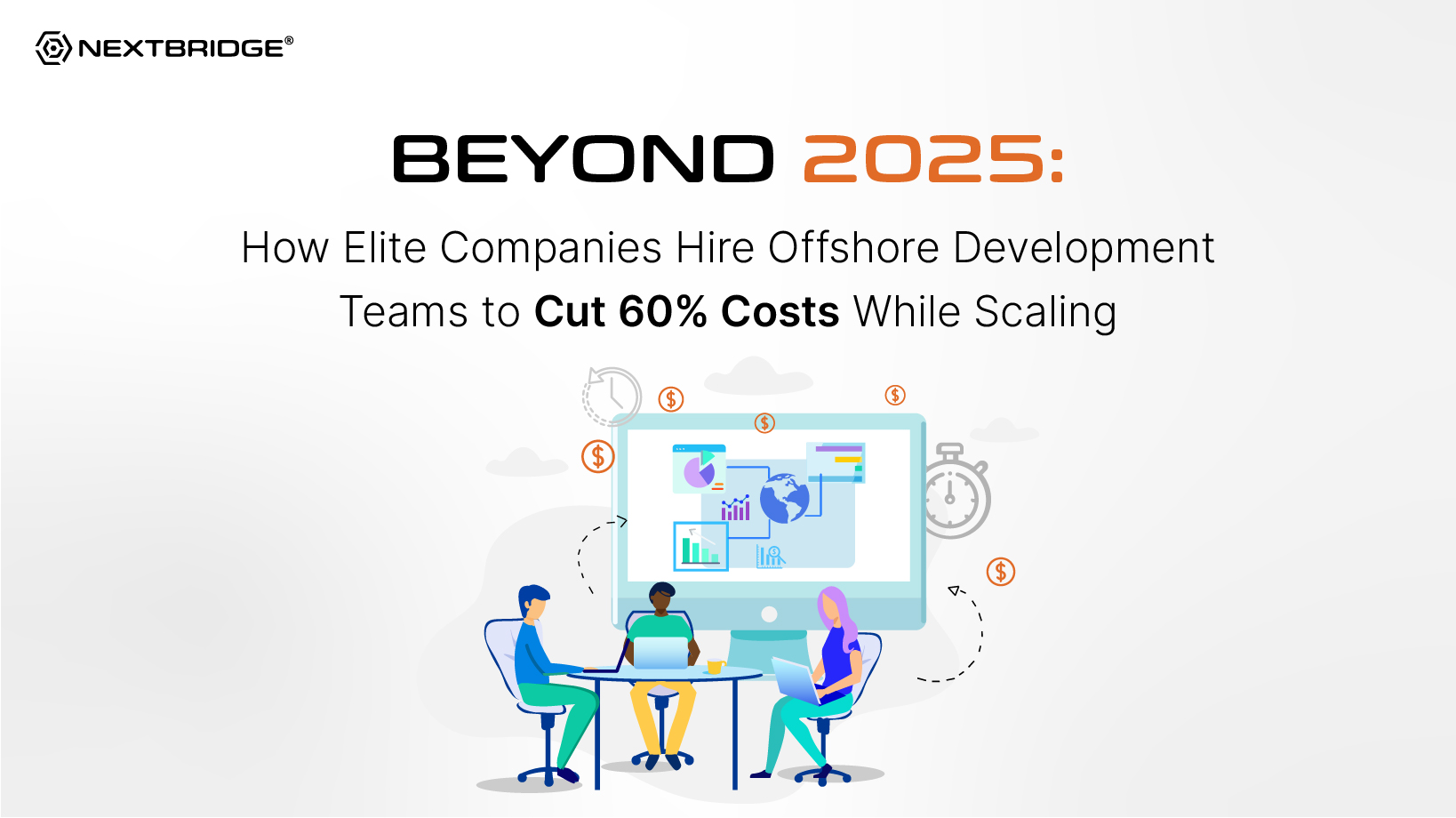 Back to all articles
Back to all articles
Blogs
Beyond 2025: How Elite Companies Hire Offshore Development Teams to Cut 60% Costs While Scaling


Do you ever think about how companies are cutting their operational cost and still thriving in the field? Here’s in 2025, most companies are undergoing a dramatic transformation of their software strategy by hiring offshore development teams. They help your company save costs while you get access to top talent across the world.
What is Software Outsourcing?
Software outsourcing is a process of appointing all or some parts of software development to service providers. This helps your company to take off the burden of in-house employees, and you don’t have to rely on them solely.
Bridging Skill Gaps
Outsourcing helps companies to get technical expertise in their project, which can be missing in their in-house team, especially in new technologies like AI/ML, automation & cloud computing.
Boosting Cost Efficiency
Get global talent with 50% less labor cost, which gives the company an upper hand in saving costs, especially for technical tasks that require an in-house strategic presence.
Accelerating Innovation
An external partner also brings new expertise and a fresh mind to the table, which can think differently. Your outsourcing partners can contribute to your projects with new ideas, intellectual property, and frameworks.
Scaling on Demand
Outsourcing companies offer access to a wide range of talent pool, which allows you to expand your team according to the changing project requirements.
Types of Outsourcing Models
This table will help you understand the basic differences between them.
| Outsourcing Model | Description | Advantages |
| Onshore | Partnering with vendors in the same country as your business (e.g., a US company working with a US-based provider). | - Seamless communication due to shared language and time zone- Cultural alignment - Easier integration with internal teams |
| Nearshore | Collaborating with teams in nearby countries with similar time zones and cultural alignment. | - Easier communication and coordination- Faster travel if in-person meetings are needed- Better cultural fit compared to offshore |
| Offshore | Working with providers in distant countries (e.g., Pakistan), often across multiple time zones. | - Substantial cost savings (over 50%)- Access to vast technical talent- Expertise in emerging tech (AI/ML, AR/VR, RPA, cloud) |
Why Hire Offshore?
There are numerous advantages of offshore hiring, some of which are
Cost Efficiency
Offshore development hiring can help you cut a huge chunk of labor costs while maintaining your same high-quality standards. It helps you save on salaries, employee benefits, and infrastructure, and you can use that cost somewhere else, like marketing or product development etc.
Global Talent Access
Globally, tech talent is in higher demand, so hiring an offshore development team can help you access to most skilled developers from different regions. They will have a strong educational background and technical expertise in their field.
Flexibility and Scalability
Hiring an offshore development team comes with the flexibility to scale up and down the team according to the project requirements. This flexibility allows you to handle fluctuating demand without hiring full-time, with efficient resource allocation.
Focus on Core Business
Offshore development task gives you extra time on hand, which can be utilized for strategic growth, initiatives, and enhancing customer experience. Hiring an offshore development team will bring you freedom to do other tasks with more energy and time.
24-hour Development Cycle
The offshore development team works in a different time zone, which keeps the development cycle going. When your in-house will ends their day offshore team will start working, you can adjust their timelines, tasks etc.
How To Hire an Offshore Development Team?
Here are the steps you must take to find and hire an offshore team of developers that can respond to your business’s unique needs.
Define Your Objectives
Firstly, define the project goals, scope, and technical requirements of your project very clearly. Add specific details like platforms, required features, and programming languages. This clarification will help you in identifying which offshore development company will align with your vision and help you achieve your benchmarks.
Research and Shortlist Providers
Start examining the portfolios, client reviews, and case studies to identify the potential providers. Prioritize those who are showing their expertise in your industry and the required tech stack. Compare their timelines, track records, customer feedback, and success stories to choose the most suited company to handle your project.
Choose an Appropriate Engagement Model
Select the engagement model that fits you the best according to your project requirements. Keep in mind all the pros and cons of each option in terms of budget, flexibility, and complexity. Mostly, fixed price models are the best for projects that have clear goals and scope. You can also hire a dedicated team model, which is perfect for large-scale or ongoing development.
Assess Technical Proficiency
Carefully evaluate the skill set of the offshore development team. Do proper interviews, review their work samples, and conduct coding tests to assess their expertise. To ensure that they can handle complex tasks efficiently, confirm their experience with platforms, tools, and methodologies.
Establish Communication Protocols
Share processes of sharing reports, feedback, and how to update managers. Use multiple collaboration tools like Trello, Slack, Jira, and Taiga for centralized communication and tracking projects.
Time Zone & Work Schedules
Coordinate together and set schedules for timely updates and smooth communication.
Nearshore teams, particularly those in regions like Latin America, offer better time zones that align with US businesses, which reduces the delays in feedback and adjustments.
Sign a Contract
Make a detailed contract that covers all the timelines, deliveries, confidentiality, and intellectual property rights. Add clear clauses for issue resolution, termination conditions and performance standards to keep both parties safe.
Conclusion
Offshore development is not just a strategy for saving costs, but it's a way to grow faster and fill the gaps to become a competitive company in the market. Hire talented staff to keep your work circle running for 24 hrs and stay up-to-date with all the latest technologies.
Get an offshore development team from the best company so you can feel safe that you are in better hands. It will ultimately cut the cost by 60%.
FAQs
How much can I really save by hiring an offshore development team?
Most companies save up to 50–60% on labor costs by offshoring, thanks to lower salaries, reduced overhead, and no expenses for employee benefits or local infrastructure.
What are the biggest risks of offshore development, and how can I manage them?
Common risks include communication barriers, time zone gaps, and quality control. You can overcome these with clear contracts, collaboration tools, regular check-ins, and choosing partners with proven track records.
Which countries are best for offshore development in 2025?
Popular offshore destinations include India, Pakistan, Ukraine, and regions like Latin America for nearshoring. These locations offer competitive rates, strong technical expertise, and large talent pools.
How do I ensure my intellectual property stays protected when outsourcing?
Always sign a detailed contract covering confidentiality, IP ownership, and security clauses. Work only with reputable partners who follow strict data protection policies and legal frameworks.
Can an offshore team handle complex or long-term projects?
Yes — many offshore teams specialize in complex, large-scale, or ongoing development. With the right engagement model, clear scope, and proper oversight, they can deliver high-quality work over extended timelines.
Don't hire us right away
talk to our experts first,
Share your challenges, & then decide if we're the right fit for you! Talk to Us
Partnerships & Recognition
Commitment to excellence






